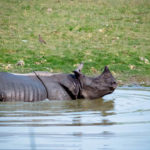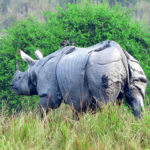Kaziranga National Park – A world heritage site, the park hosts two-thirds of the world’s Great One-horned rhinoceros. Kaziranga
The history of Kaziranga as a protected area can be traced back to 1904, when Mary Victoria Leiter Curzon, the wife of the Viceroy of India, Lord Curzon, visited the area. After failing to see a single rhinoceros, for which the area was renowned, she persuaded her husband to take urgent measures to protect the dwindling species which he did by initiating planning for their protection. On 1 June 1905, the Kaziranga Proposed Reserve Forest was created with an area of 232 km2 (90 sq mi).
Over the next three years, the park area was extended by 152 km2 (59 sq mi), to the banks of theBrahmaputra River. In 1908, Kaziranga was designated a Reserve Forest. In 1916, it was converted to a game sanctuary—The Kaziranga Game Sanctuary—and remained so till 1938, when hunting was prohibited and visitors were permitted to enter the park.
The Kaziranga Game Sanctuary was renamed the Kaziranga Wildlife Sanctuary in 1950 by P. D. Stracey, the forest conservationist, in order to rid the name of hunting connotations. In 1954, the government of Assam passed the Assam (Rhinoceros) Bill, which imposed heavy penalties for rhinoceros poaching. Fourteen years later, in 1968, the state government passed ‘The Assam National Park Act of 1968’, declaring Kaziranga a designated national park. The 430 km2 (166 sq mi) park was given official status by the central government on 11 February 1974. In 1985, Kaziranga was declared a World Heritage Site by UNESCO for its unique natural environment Kaziranga has witnessed several natural and human-made calamities in recent decades. Floods caused by overflowing of river Brahmaputra have led to significant losses of animal life. Encroachment by humans along the periphery also has led to a diminished forest cover and a loss of habitat.
The park celebrated its centenary with much fanfare in 2005, inviting descendants of Baroness and Lord Curzon for the celebrations. In early 2007, elephants and two rhinoceros were relocated toManas National Park, the first instance of relocation of elephants between national parks in India.















